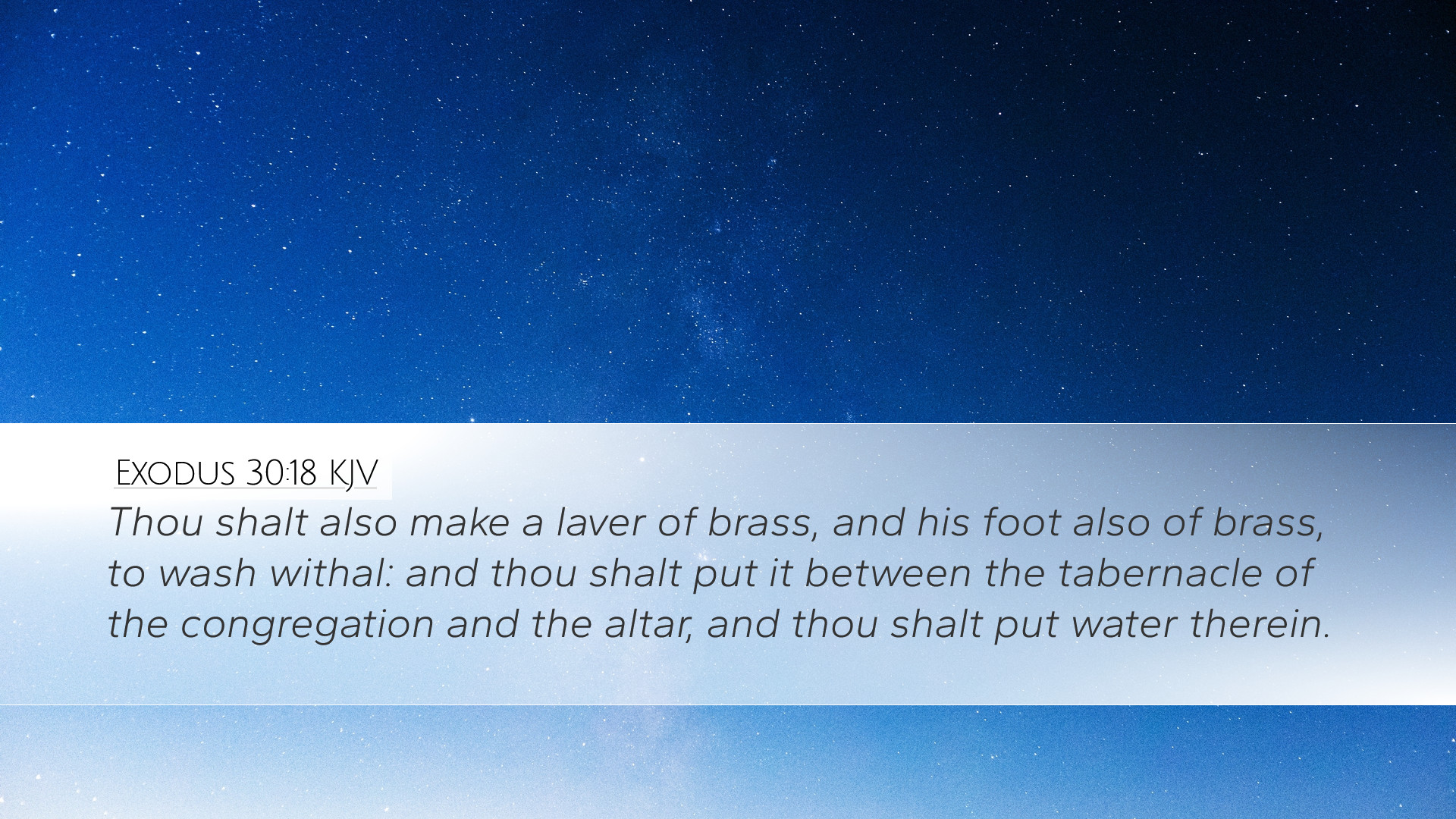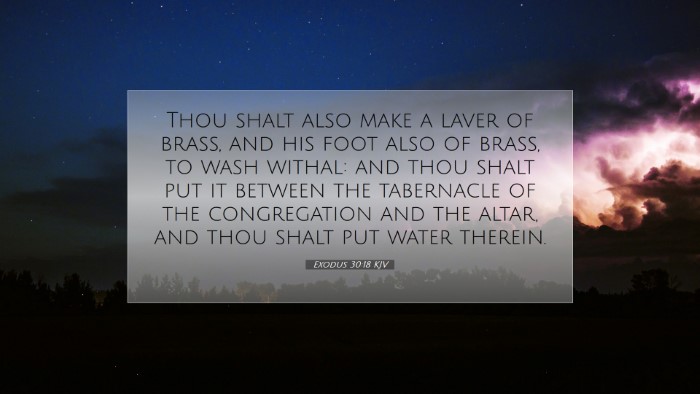Commentary on Exodus 30:18
Verse: "Thou shalt also make a laver of brass, and his foot also of brass, to wash withal: and thou shalt put it between the tent of the congregation and the altar, and thou shalt put water therein."
Introduction
Exodus 30:18 is a pivotal verse in the description of the furnishings of the Tabernacle and their significance in the worship of God in the Old Testament. In this verse, the command for the construction of the bronze laver highlights crucial themes of purity, ceremonial cleansing, and preparation for service in the presence of God. This commentary synthesizes insights from various public domain sources, including the works of Matthew Henry, Albert Barnes, and Adam Clarke, offering a meaningful confluence of thoughts for pastors, students, theologians, and Bible scholars.
Contextual Analysis
The context of this verse is particularly important, as it is part of the instructions given to Moses regarding the worship practices in Israel. Surrounding this verse, we see specifications concerning the priestly garments, the anointing oil, and the incense of sweet spices (Ex. 30:22-38). The laver serves as a practical means of maintaining ceremonial cleanliness before the priests approach the altar for sacrifice, symbolizing not only physical but also spiritual purification.
Moses and Divine Instruction
Here, Moses receives direct instruction from God about the materials necessary for worship. The mention of "brass" signifies durability and strength, echoing the idea that the laver is intended for frequent use. As Albert Barnes noted, "The laver was used by the priests for their daily cleansing, which was a symbolic act representing the need for purification before approaching God."
This foreshadows the cleansing needed for all believers, ultimately fulfilled by Christ.
Symbolic Interpretation
The construction of the laver and its placement holds deep significance. It is situated "between the tent of the congregation and the altar," indicating that washing must precede sacrifice. Matthew Henry emphasizes this point by stating, "No man can come to God in an acceptable manner unless he comes cleansed." The laver represents the necessary step of purification, setting the stage for one’s sacrifice and worship.
The Laver and its Purpose
- Cleansing Before Worship: The priest must wash their hands and feet before approaching the altar (Ex. 30:19). This ritual signifies the need for holiness and purity as required for communion with God.
- Symbol of Christ: Adam Clarke points out that the laver is emblematic of the Word of God, which sanctifies believers—"now ye are clean through the word which I have spoken unto you" (John 15:3). This presents a rich typology linking the Old Covenant practices with the New Covenant realities.
- Spiritual Significance: The need for purification speaks to the broader personal conviction of believers. Just as the priests had to ensure they were ritually clean, modern believers must continuously seek spiritual cleansing through repentance and the grace of God.
Practical Applications
For modern-day Christians, Exodus 30:18 serves as a reminder of the importance of spiritual hygiene. The laver represents a necessary reflection point, urging believers to consider their readiness to approach God. This verse carries implications for pastoral care, emphasizing the continual need for self-examination and repentance among both clergy and laity alike.
Reflections for Pastors and Theologians
- Encouragement to Purity: Pastors are called to encourage their congregations to engage in practices that facilitate spiritual cleansing—through prayer, confession, and studying the Word.
- Educational Focus: Theologians and students should recognize the importance of understanding Old Testament rituals to fully grasp the significance of New Testament doctrines regarding holiness and sanctification.
- Symbolism in Worship: The brazen laver's symbolism invites worship leaders to integrate elements of confession and cleansing into corporate worship settings, thus fostering a culture of heartfelt repentance.
Concluding Thoughts
Exodus 30:18, while detailing a specific instruction in a bygone era, echoes timeless truths that resonate with believers today. The call to holiness, the need for purification, and the foreshadowing of Christ's ultimate sacrifice imbues this verse with profound spiritual significance. Through the lens of scriptural commentaries by Henry, Barnes, and Clarke, we uncover layers of meaning that challenge and inspire us to approach God with reverence, acknowledging our need for grace and cleansing.


